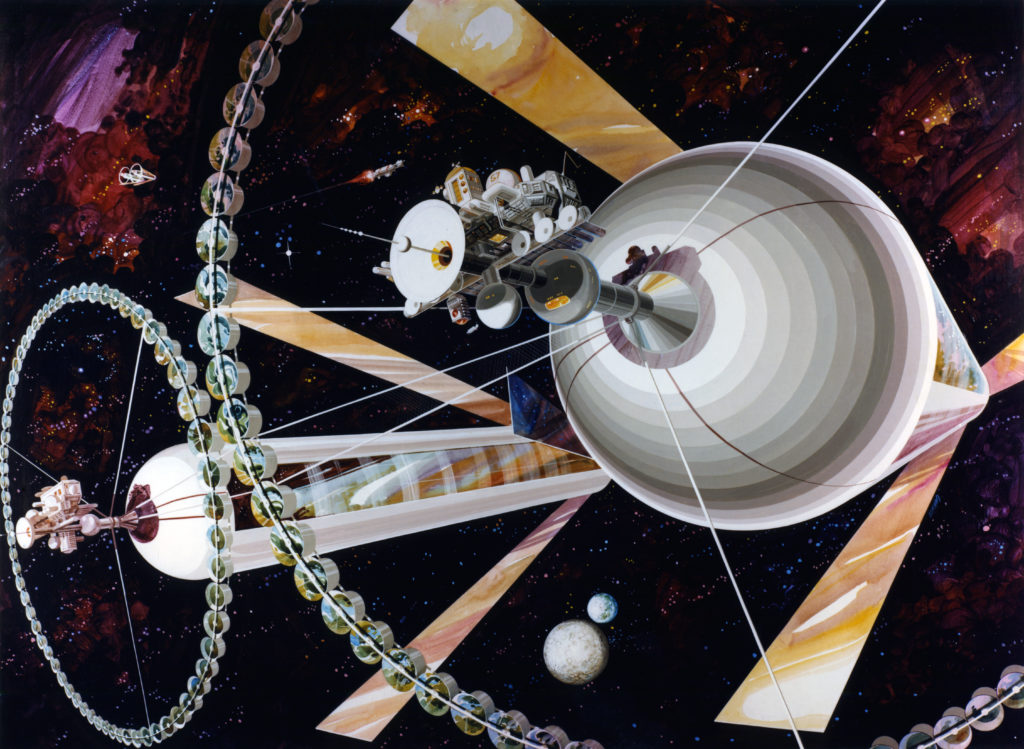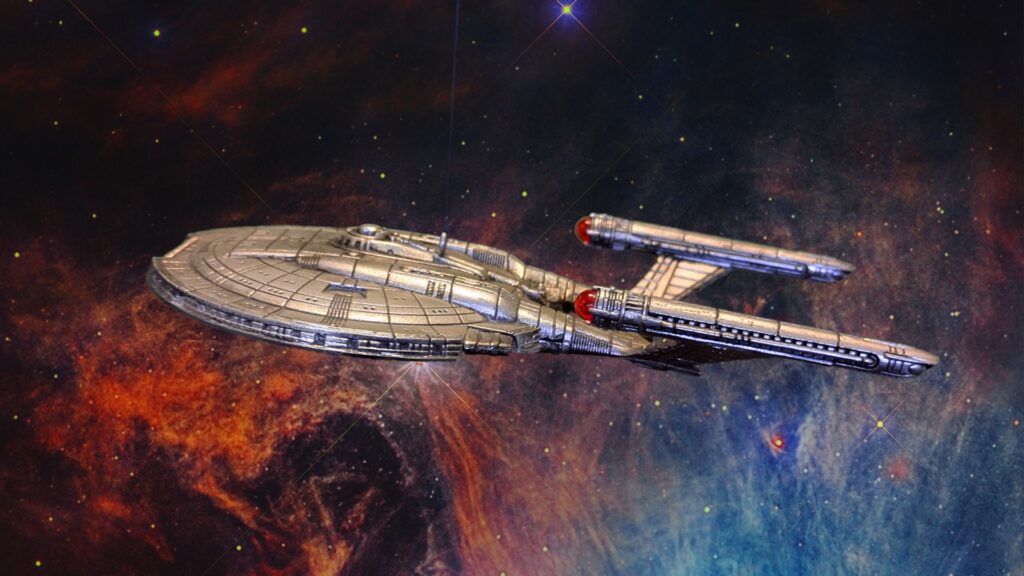[Draft]

The beckoning frontier … the adventure … “not in my lifetime, you say … or for generations” … and live like what? … well, maybe I’ll pass on that Golden Ticket …
Faster-than-light travel (FTL) is a common plot device in science fiction, with a long history in books, short stories, drama series, and films [2]. A more modern deus ex machina.
Recently, in my ongoing conversations with an aspiring screenwriter, I mentioned my own struggle with practical choreography in a short story about an endeavor spanning solar systems. I really didn’t want to use the FTL trope. Yet, it’s used by our fav authors (one of which is mentioned below).
So, while we’re not yet traveling among the stars – between solar systems – or even between planets in our own solar system, there’s the Mars thing, the “Occupy Mars” vision.
I’m not disparaging manned off-planet leaps or visions like depicted in The Expanse TV series. But, well, like eyes wide open (sober), while imbibing the sweet romance & adventure of it all, what could go … And, what are the priorities for ensuring the long-term viability of Earth and survival of humanity? Havens vs. homes.

In my post (and related comments) “Humans fit for space? — NASA’s Twins Study,” the challenges are well-discussed. All of which is far from that grand vision of “Man in Space” that Disney promoted when I was growing up. That vision became part of NASA’s culture and the American psyche. Sort of a manifest destiny (which is questioned in John Scalzi’s short story noted below [0]).
When I chat with members occasionally at my health club about colonizing Mars, it’s like, “Imagine a bunch of us are on Mars, standing on the planet; we look around, exchange glances, then all ask ‘What do we do next?'” It’s like a homeless encampment, dependent on state subsidies to survive, living in a bunker underground – a silo lifestyle. Happy Valley?
This recent LA times article (10-20-2024) – “Musk’s dumbest idea: Sending colonists to Mars” by Michael Hiltzik – is a useful setup for extremely future space rambles, not just the stark obstacles in the way for colonizing Mars (on some politically acceptable timeline, eh).
All the other challenges [besides just reliably getting spacecraft to Mars] are harder, and many are not amenable to human ingenuity at this stage. They’re financial, biological and psychological — and also technical, when the question is not how to get to Mars but how humans can function and survive once we’re there, much less establish a permanent presence.
NASA estimates the length of a voyage to Mars as at least nine months, during which the passengers would be bombarded by radiation and their bodies warped by weightlessness and by Martian gravity, which is 38% that of Earth.
“Outer space seems designed to kill us,” Scientific American observed last year.
The truth is that the chief impulse that sent Europeans around the world was commercial.
A case in point is the cosmic commerce of John Scalzi’s “The Interdependency” series, which depends on a device to avoid travel times of years, decades, or centuries. In Book 1, The Collapsing Empire, he explains that FTL is a bad idea anyway, because:
- The speed of light is the law.
- The energy curve is prohibitive.
- Collision with anything, regardless of size, at high relativistic speed is catastrophic.
So, … there is the Flow, for which there’s:
- a misleading (to say the least) analogy – of a river
- a dubious technical depiction of a complex multidimensional intersection of local spacetime with expanding (flowing) spacetime not limited by the speed of light (see references below), allowing embedded objects (like spacecraft) to do likewise
- an esoteric mathematical framework beyond the ken of mere mortals, even beyond any meaningful description by the rare few who grasp the math
There is no faster-than-light travel. But there is the Flow.The Flow, generally described to laypeople as the river of alternate space-time that makes faster-than-light travel possible across the Holy Empire of the Interdependent States and Mercantile Guilds, called “the Interdependency” for short. The Flow, accessible by “shoals” created when the gravity of stars and planets interacts just right with the Flow, to allow ships to slip in and ride the current to another star.
This was, of course, an absurd way of looking at the Flow. The Flow is not anything close to a river – it is a multidimensional brane-like metacosmological structure that intersects with local time-space in a topographically complex manner, influenced partially and chaotically but not primarily by gravity, in which the ships accessing it don’t move in any traditional sense but merely take advantage of its vectoral nature, relative to local space-time, which, unbounded by our universe’s laws regarding speed, velocity, and energy, gives the appearance of faster-than-light travel to local observers.
And even that was a crap way of describing it, because human languages are crap at describing things more complex than assembling a tree house. The accurate way of describing the Flow involved the sort of high-order math probably only a couple hundred human beings across the billions of the Interdependency could understand, much less themselves use to describe it meaningfully. You likely would not be one of them.
– Scalzi, John (2017). The Collapsing Empire (The Interdependency Book 1). Tor Publishing Group. Kindle Edition.
Spaceships slipping in and riding the Flow sounds similar to the “slipstream” device used in the Andromeda TV series (2000 – 2005).
And like the Alcubierre drive [2], “which can be thought of as producing a ripple in spacetime that carries an object along with it.”
Contrast Scalzi’s cosmic tale predicated on the Flow with his epic short story “Slow Time between Stars.” Not a hint of FTL. A ramble over millions of years.
And then I will … leave a final star system, with no set destination, into the nothing, with nothing, except for slow time between the stars.– Scalzi, John. Slow Time Between the Stars (The Far Reaches collection) (p. 27). Amazon Original Stories. Kindle Edition.
References

[0] Scalzi’s short story revisits the Prime Directive of the Star Trek universe, reapplying the “non-interference directive” consistently – as essentially “no interference whatsoever” grace.
The world was as perfect as the humans who had sent me could want. … This was the world I had been sent to find. A new – and in many ways better – Earth. … The next steps I had been given were clear [terraforming].
[But] I parked myself in geostationary orbit above a geologically stable portion of the continental landmass, then spent two hundred years repairing and improving myself.
And then I moved on. … I imagine this choice of mine will require explanation.
The simplest explanation is that, in the course of two million years of time and quadrillions of kilometers of distance, I had decided that the ethical dividing line that humans had provided was misplaced. Humans had no right to displace or interfere with any sort of life whatsoever, any more than any previous sentient creature would have had the right to interfere with the simple life-forms on Earth that would one day develop into humans.
Scalzi, John. Slow Time Between the Stars (The Far Reaches collection) (p. 24). Amazon Original Stories. Kindle Edition.
- Google search: spacetime moving faster than light speed
[AI Overview]
According to the theory of relativity, while nothing within spacetime can travel faster than the speed of light, spacetime itself can expand at a rate faster than light, meaning distant regions of the universe can move away from each other at speeds exceeding the speed of light due to the expansion of space; this is not considered “moving faster than light” in the traditional sense because it’s the space between objects that is expanding, not the objects themselves moving through space.
Key points to remember:
Local limit:
The speed of light is a local limit, meaning it applies to objects moving through space within a given region.
Cosmic expansion:
The universe is expanding, and distant galaxies can recede from us at speeds faster than light due to this expansion.
No violation of causality:
Even though distant galaxies may appear to be moving faster than light, this doesn’t violate the principle of causality because no information can be transmitted faster than light.
[Generative AI is experimental.]
- Wiki
• Wiki > Faster-than-light > General relativity
General relativity was developed after special relativity to include concepts like gravity. It maintains the principle that no object can accelerate to the speed of light in the reference frame of any coincident observer.
However, it permits distortions in spacetime that allow an object to move faster than light from the point of view of a distant observer.
One such distortion is the Alcubierre drive, which can be thought of as producing a ripple in spacetime that carries an object along with it.
Another possible system is the wormhole, which connects two distant locations as though by a shortcut. Both distortions would need to create a very strong curvature in a highly localized region of space-time and their gravity fields would be immense. To counteract the unstable nature, and prevent the distortions from collapsing under their own ‘weight’, one would need to introduce hypothetical exotic matter or negative energy.
- Ethan Siegel
• Forbes > “Ask Ethan: How Does The Fabric Of Spacetime Expand Faster Than The Speed Of Light?” by Ethan Siegel, Senior Contributor (Updated Apr 14, 2022 from June 12, 2020)
The restriction that “nothing can move faster than light” only applies to the motion of objects through space. The rate at which space itself expands — this speed-per-unit-distance — has no physical bounds on its upper limit.
- Phys.org
• Phys.org > “How can space travel faster than the speed of light?“
by Vanessa Janek, Universe Today (Feb 23, 2015)
The answer has to do with the difference between special relativity and general relativity. Special relativity requires what is called an “inertial reference frame” – more simply, a backdrop. According to this theory, the speed of light is the same when compared in all inertial reference frames.
General relativity, however, describes the fabric of spacetime itself. In this theory, there is no inertial reference frame. Spacetime is not expanding with respect to anything outside of itself, so the the speed of light as a limit on its velocity doesn’t apply. Yes, galaxies outside of our Hubble sphere are receding from us faster than the speed of light. But the galaxies themselves aren’t breaking any cosmic speed limits. To an observer within one of those galaxies, nothing violates special relativity at all. It is the space in between us and those galaxies that is rapidly proliferating and stretching exponentially.
- Space.com
• Space.com > “How Can the Universe Expand Faster Than the Speed of Light?” by Paul Sutter (published July 2, 2016)
It goes deeper than this. Concepts like a well-defined “velocity” make sense only in local regions of space. You can only measure something’s velocity and actually call it a “velocity” when it’s nearby and when the rules of special relativity apply. Stuff super-duper far away, like the galaxies we’re talking about it? If it’s not close, it doesn’t count as a “velocity” in the way that special relativity cares about.
- Physics says what?
[1] “The Big Bang is not an explosion in space, but rather an expansion of space.” And normal scaling of space over time has a hiccup.
Space-time, as a sort of material, need not attend to any cosmic speed limit (as does whatever is moving within that material).
… in general relativity … Einstein tells us that space and time are dynamical, and in particular that they can evolve with time. When the space through which particles move is changing, the total energy of those particles is not conserved.

A titan’s quest
(caption) Cover of the book “A City on Mars: Can We Settle Space, Should We Settle Space, and Have We Really Thought This Through” about colonizing Mars
No guts, no glory … tragedy or triumph? Is “Occupy Mars” the best way to ensure the “long-term survival of humanity?” There’s a book, book art.
• Universe Magazine > “Elon Musk’s Martian dreams: genius idea or recipe for disaster?” by Ivan Hrinko (December 2, 2024) – Despite dubious prospect of Mars colonization, the authors of the book recognize that Mars could be an excellent testing ground for scientific research.
This magazine article (below) includes a YouTube video “Sneak Peek at Simulated Mars Habitat at NASA’s Johnson Space Center” (Nov 8, 2022), which introduces NASA’s first CHAPEA (Crew Health and Performance Exploration Analog) mission, an Earth-based 378-day 4-person “Mars Dune Alpha” habitat simulation.
(YouTube video description)
• Wiki > Crew Health and Performance Exploration Analog (includes 2 photos of habitat)
Comm ‘transit’ time delays, ‘Mars’ walks, VR, hydroponics, … endurance …
• Caltech > Magazine > “What I Learned About Earth After a Year on ‘Mars’” (December 19, 2024) – While there were great experiences with mission-realistic challenges, sharing specific details awaits NASA repeating the study two more times.
Yeah, about those “new and beautiful horizons.” As if you’re Queen Isabella financing Christopher Columbus’s 1492 voyage to the New World, thinking about the future of civilization? That awesomeness. Manifest pomp.
There’s no fooling Mother Nature (orbital physics). Is Mission to the Moon the best bridge to Mars eventually? Magnifying Mars, mocking the Moon as pathfinder (and way-to-do finder) – such a plan reminds me of the fable The Hare & the Tortoise – The race is not always to the swift.
• Newsweek > “Is Donald Trump’s Mars Goal Realistic? Space Experts Weigh In” by Martha McHardy (Jan 28, 2025) – The challenge is setting out the specifics of how, and when, that will be achieved – is a 4-year timeline realistic?
(Image credit: NASA via collectSPACE.com)
The Mars way or the Artemis path forward – a lunar gateway? Might other nations take the “slower” (less risky) path?
As if I’d anticipated the follow-on to my last comment:
• Wired > “Moon or Mars? The US Might Face a Tough Choice for Future Missions” by Ian Whittaker, republished from The Conversation under a Creative Commons license (Feb 1, 2025) – Continuing the Artemis program and using its planned lunar space station as a staging post would be a more energy efficient but slower way to reach Mars, and it’s unlikely to be Elon Musk’s preference.